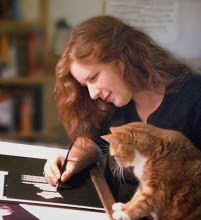This is from a photo out of the reference library on WetCanvas, I loved the expression and was excited about the challenge of doing the pillow/blanket.
As always it started with a sketch...

And the sketch was transferred to the board with graphite (I still prefer using a graphite stick directly to the back of my sketch for transferring rather than transfer or graphite paper, it just works best for me).
Stage 1 (underpainting):
This one is a whiteboard so rather than get right into the scratching it starts with a painting in ink. The biggest thing I learned about whiteboard underpaintings is to go much darker than I think - remember, from here on it's going to be taking ink off and re-applying it, but more always goes than what gets put back!

Stage 2 (first scratching):
I always feel like 'why did I bother putting this ink on' and from a distance it looks like I'm scratching it all off, but if you look at the close-up shots of the final piece you will see the incredible amount of depth and colour variation this technique gives - it means many more hours of work on the image, but the end result is well worth it!

I couldn't resist working on those limpid eyes...
 You can see how pale this is now - it leaves the deepest colours still dark but more ink will be needed on the mid-tones.
You can see how pale this is now - it leaves the deepest colours still dark but more ink will be needed on the mid-tones.Stage 3 (re-inking):
Here comes that depth - the goal in this stage is to use colours with values slightly different (ie lighter or darker) than the background. If I use the same colour I will actually cancel out any scratches I've made, but if my ink is a little bit lighter I will dampen the contrast to get a more natural look and I can use subsequent layers of ink and scratching to get the feeling of a thick, deep coat.

And you can spot the oopsie... on the left side of the nose (our right) there's a dark little spot - that is actually a small ding to the clay. It might have happened when the clay was wet after a wash of ink as it is very sensitive during that time. Here I've inked it and will use layers of ink and scratching to try to cover that defect. Yes, this made me very sad and I blame the fat cat for it.

Stage 4+ (more scratching):
There are actually multiple stages in here of scratching areas, re-inking to keep my values where I want them, scratching more for texture, and so on. You can see that my extensive medical attention to the nose blemish was successful!

This is also where I went to town on the pillow - I wanted it to look like flannel (what could be more cozy than a labrador on a flannel pillow?). I have fibreglass brushes in two sizes that help me achieve the soft, knobbly look here.
After this there are more hours of tweaking - inking, letting it dry, rescratching, re-inking. There is usually a point where either I've reached a deadline or the painting just says 'stop'. That is when I know I'm done and we're ready for framing. My absolute favorite bit which I save for last is the whiskers! That and a signature and....
..the finished product!
Detail shots (larger than life-size):



This one is available for sale ($250.00, includes basic frame matted to 12x12"). It is not yet uploaded to the website (quick note, the website is currently under construction getting a bit of an update) but if you are interested just email me at pam@catinaboxstudio.com!
As always - if you're interested in a commissioned pet portrait send me an email or give me a call (I have a brochure in PDF form for anyone who wants more detail on ordering a commission).
And as always, thank you for stopping by and peeking at my blog!!
(PS - so does this one qualify as dog #8 in the 100 dogs challenge?)






2 comments:
wow, thats incredible detail!
Thanks!
Post a Comment